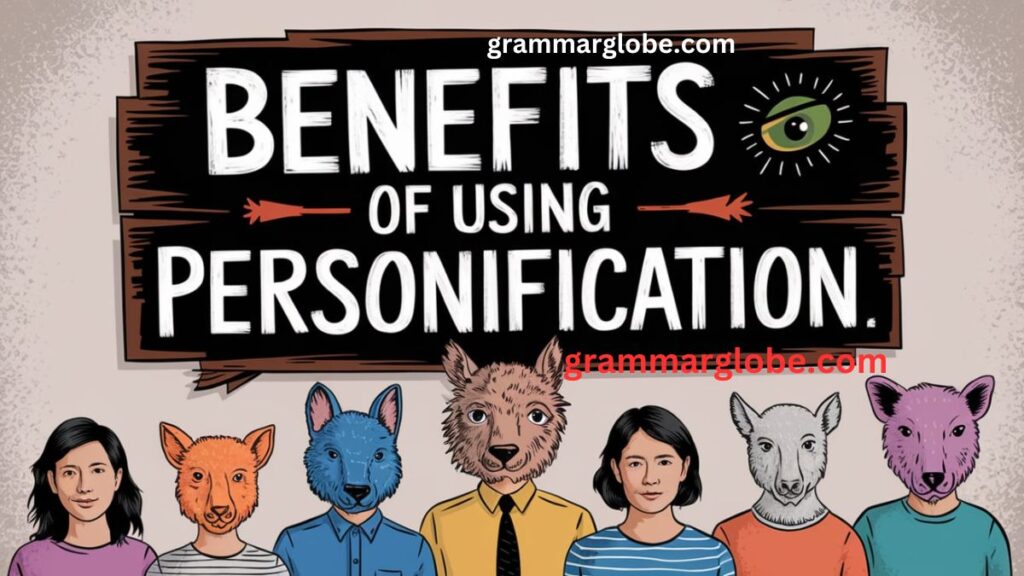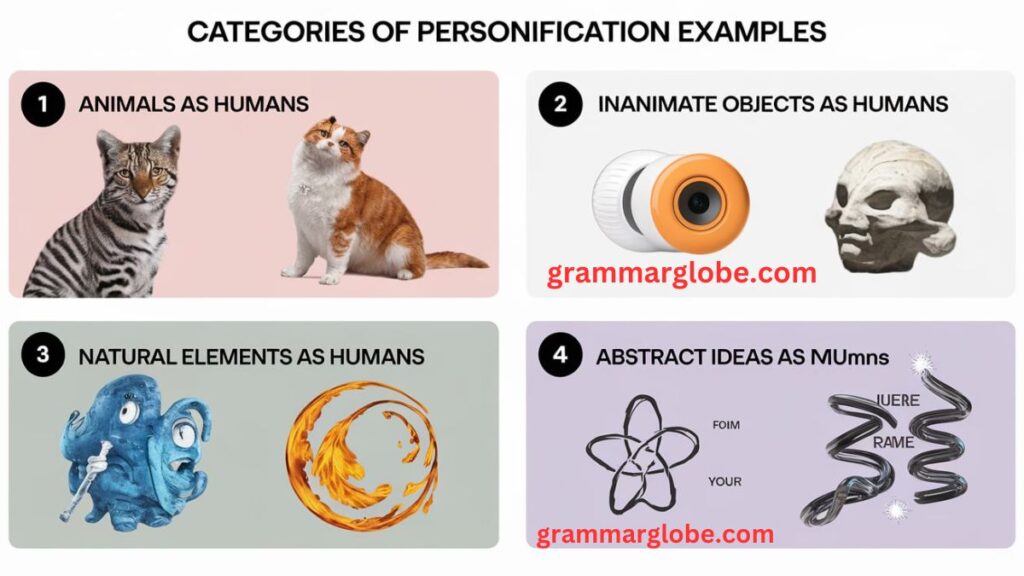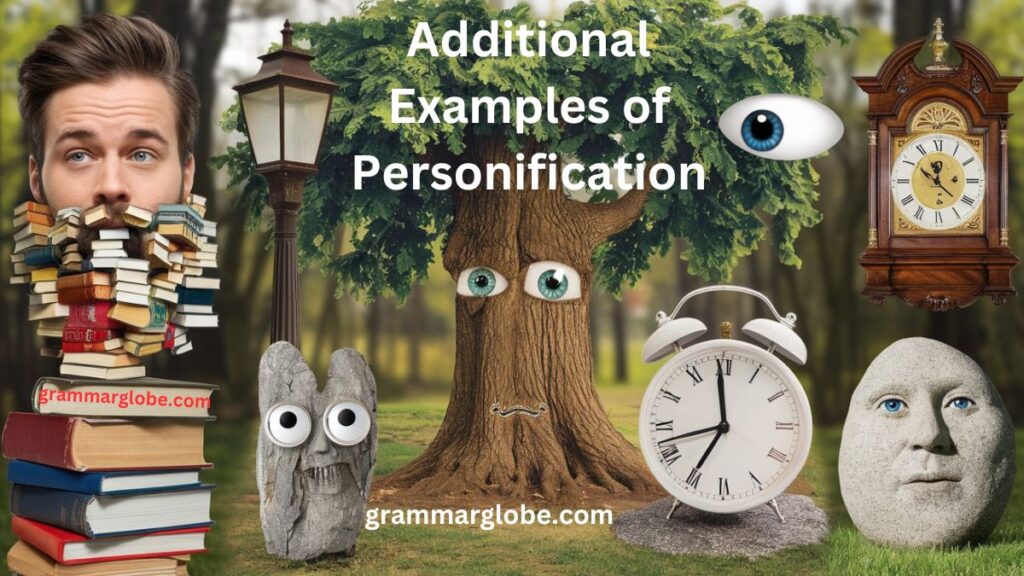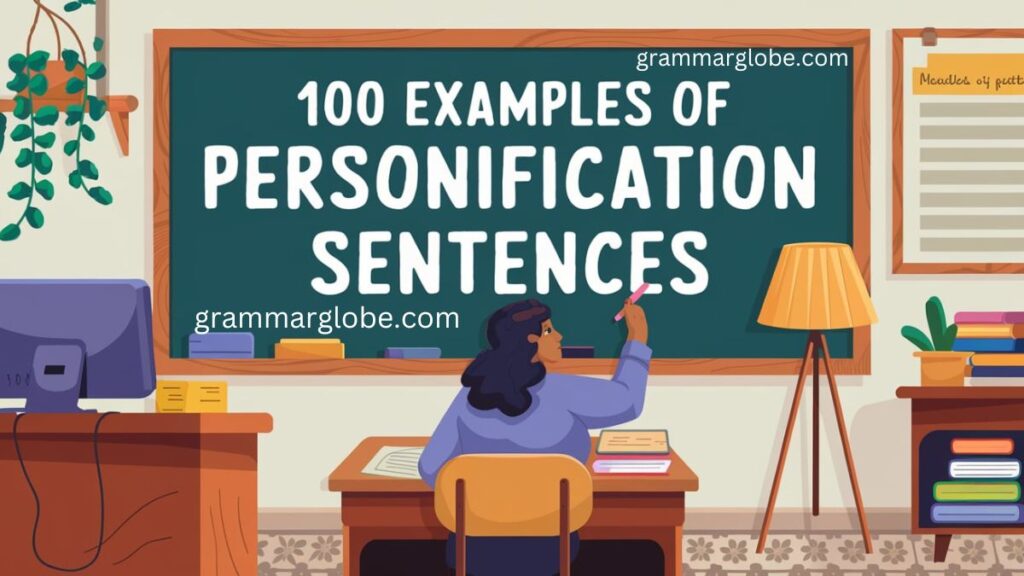Personification is one of the most vivid and powerful literary techniques used to breathe life into the non-living. By attributing human characteristics to objects, animals, or abstract concepts, personification helps readers form deeper connections with the world around them. Imagine the wind whispering through the trees, the sun smiling down on a field of flowers, or the clock scolding you for being late. These are all examples of personification at work, transforming ordinary scenes into magical, relatable moments.
In writing, personification can enhance both descriptive and narrative elements. It creates mental pictures, evokes emotions, and allows readers to experience the world in a more personal and engaging way. Whether in poetry, storytelling, or everyday conversation, personification can turn mundane objects and events into characters with personalities, actions, and desires.
What is Personification?
Personification is a form of figurative language where human attributes are applied to non-human subjects. This literary technique allows writers to:
- Enhance storytelling by making descriptions more engaging.
- Build emotional connections between the reader and the subject.
- Create vivid imagery that stimulates the imagination.
For instance, instead of saying, “The wind was strong,” personification could transform it into, “The wind whispered through the trees,” evoking a stronger emotional and visual response.
Benefits of Using Personification

1. Enhances Imagery
- By assigning human features to non-human elements, descriptions become more relatable and memorable.
- Example: “The sun smiled warmly as it rose over the horizon.”
2. Elicits Emotions
- It allows readers to connect emotionally with the scene or object being described.
- Example: “The old house mourned its fading beauty, its shutters hanging like tears.”
3. Strengthens Creativity
- Encourages imaginative thinking by blending reality with abstraction.
- Example: “The stars winked mischievously from the night sky.”
Categories of Personification Examples
To make the 117 Examples of Personification Sentences more digestible, we’ve organized them into thematic categories:

Nature and Weather
- “The wind whispered secrets to the trees.”
- “The thunder grumbled in the distance, plotting its next move.”
- “The sun danced cheerfully across the sky.”
- “Raindrops tapped a rhythm on the roof.”
- “Storm clouds howled with fury.”
- “The ocean waves sang a soothing melody.”
- “The snowflakes kissed the ground softly.”
- “The fog wrapped its arms around the city.”
- “The leaves giggled as the wind passed through.”
- “The mountains stood guard, proud and tall.”
Objects
- “The clock stared at me, its ticking filled with impatience.”
- “The teapot hummed a happy tune.”
- “The mirror mocked my disheveled appearance.”
- “The car groaned as it struggled up the hill.”
- “The gate creaked a mournful goodbye.”
- “The lamp frowned when its bulb went out.”
- “The shoes danced across the floor at the party.”
- “The refrigerator complained about being overstuffed.”
- “The book opened its arms to reveal a new adventure.”
- “The chair sighed under the weight of the visitor.”
Animals
- “The dog smiled warmly at its owner.”
- “The cat danced gracefully across the room.”
- “The bird sang with joy at the break of dawn.”
- “The squirrel waltzed through the branches, proud of its acrobatics.”
- “The mouse whispered its secrets to the darkness.”
- “The fox grinned mischievously before darting into the woods.”
- “The horse bowed its head in quiet agreement.”
- “The owl winked mischievously from its perch.”
- “The bees danced among the flowers.”
- “The fish laughed as it leapt out of the water.”
Time and Abstract Concepts
- “Time raced ahead, leaving me breathless.”
- “Hope smiled shyly from the shadows.”
- “Fear knocked persistently at my door.”
- “Love embraced us warmly on that cold night.”
- “Ambition whispered dreams into my ears.”
- “Sadness wrapped its arms around me tightly.”
- “Happiness skipped into the room, lighting up every corner.”
- “Jealousy hissed in the background, waiting for its chance.”
- “Anger growled deep within my chest.”
- “Joy danced through the crowd, spreading laughter and smiles.”
Everyday Life
- “The city hummed with endless energy.”
- “The alarm clock screamed me awake.”
- “The curtains danced in the breeze.”
- “The coffee maker chattered excitedly as it brewed.”
- “The shopping bags groaned under their heavy load.”
- “The oven sighed as it heated up for another meal.”
- “The floorboards creaked their protest with each step.”
- “The door yawned open, inviting us in.”
- “The computer grumbled as it struggled to process the data.”
- “The backpack hugged my shoulders tightly.”
- “The pillow welcomed my head with a soft sigh.”
- “The bicycle groaned as I pedaled up the steep hill.”
- “The phone begged for attention with its constant buzzing.”
- “The kettle whistled a tune as the water boiled.”
- “The notebook whispered secrets of creativity on its blank pages.”
- “The candles flickered nervously in the draft.”
- “The washing machine danced with determination as it spun.”
- “The keys laughed as they jingled in my pocket.”
- “The umbrella sighed with relief as it shielded me from the rain.”
- “The camera captured the moment with a joyful click.”
Additional Examples of Personification

Nature and Weather
- “The stars winked mischievously from the night sky.”
- “The moon smiled shyly as it rose.”
- “The river danced over the rocks.”
- “The storm clouds plotted their next move.”
- “The frost nipped at my fingers.”
- “The sunbeam kissed my cheeks.”
- “The shadows sneaked quietly through the room.”
- “The flowers waved hello in the gentle breeze.”
- “The oak tree stood proudly, guarding the meadow.”
- “The fire crackled with glee.”
Objects
- “The path beckoned me forward.”
- “The walls listened intently to our conversation.”
- “The shoes sighed after a long day of walking.”
- “The candlelight danced on the walls.”
- “The alarm clock grumbled as I hit the snooze button.”
- “The windowpane wept with condensation.”
- “The chair hugged me as I sank into its cushions.”
- “The scissors complained about cutting through tough fabric.”
- “The pencil raced across the page.”
- “The blanket whispered comfort as I wrapped it around me.”
Abstract Concepts
- “Courage stood tall in the face of adversity.”
- “Grief sat quietly in the corner, watching over the room.”
- “Dreams tiptoed into my mind as I drifted off to sleep.”
- “Luck smiled upon us during the game.”
- “Peace blanketed the valley after the storm.”
- “Chaos danced wildly during the festival.”
- “Wisdom nodded approvingly as I made my decision.”
- “Imagination painted vivid pictures in my thoughts.”
- “Patience waited silently for its moment.”
- “Memory tugged at my heartstrings, replaying old times.”
- The wind sang a haunting tune as it wove through the canyon.
- The campfire crackled with excitement, eager to share its warmth.
- The moon peeked shyly from behind the clouds, as if unsure of its glow.
- The forest held its breath, waiting for the dawn to arrive.
- The bridge groaned in protest as the heavy truck rumbled across.
- The shadows danced on the walls, playing a silent game of tag.
- The ice on the pond shivered under the weight of the children skating.
Everyday Life
- “The sink gurgled happily as the water drained.”
- “The table groaned under the weight of the feast.”
- “The garden stretched awake as the sun rose.”
- “The television blinked to life with a hum.”
- “The fence stood firm, defying the strong winds.”
- “The coat hugged me against the winter chill.”
- “The clock hands waved goodbye to the passing hours.”
- “The books on the shelf whispered tales of adventure.”
- “The pot bubbled with excitement as the stew cooked.”
- “The pen danced gracefully across the paper.”
- The sun rises each morning, casting a golden glow over the city as people begin their daily routines.
- The coffee machine hums quietly, eager to start the day with a fresh brew.
- The bus pulls away from the stop, carrying passengers who are lost in their thoughts or their phones.
- The traffic light flickers, impatiently waiting to change as cars line up at the intersection.
- The sound of footsteps echoes in the hallway, signaling another busy workday ahead.
- The kettle whistles, alerting the household that it’s time for tea.
- The dog wags its tail happily, excited for its morning walk.
- The clock ticks steadily, counting down the minutes until it’s time for lunch.
- The dishes clink together as they are washed, a quiet rhythm to the end of a meal.
- The evening sky turns shades of pink and purple, signaling the end of another ordinary day.
Closing Sentences
Personification is more than just a literary device; it’s a gateway to creativity and connection. By assigning human features to the inanimate, it allows writers to evoke emotions, paint vivid imagery, and breathe life into their words. The 110 Examples of Personification Sentences shared here are just a glimpse of the boundless possibilities this figurative language offers.
Whether you’re crafting a story, poem, or simply want to add flair to your descriptions, personification can transform your writing from mundane to magical. Let these examples inspire you to explore new ways of bringing your words to life!
FAQs:
What is personification in literature?
Personification is a literary device where non-human objects, animals, or abstract concepts are given human qualities or characteristics. This technique helps make descriptions more vivid and relatable, allowing readers to connect with inanimate things in a new, emotional way.
Why is personification important in writing?
Personification brings life to ordinary objects, making them more engaging and memorable. It enhances storytelling by creating rich imagery and emotional connections, allowing readers to experience scenes more personally and imaginatively.
Can personification be used in everyday writing?
Yes! Personification can be applied in any form of writing, whether it’s fiction, poetry, or even casual conversations. It helps make descriptions more interesting and vivid, adding depth to the way we talk about the world around us.
How can I use personification in my own writing?
To use personification, think about an object, animal, or idea, and consider what human traits it might have. For example, “The wind howled through the trees” gives the wind a human action. You can experiment with different qualities such as emotions, actions, or thoughts for greater impact.
Are the examples in the article suitable for all ages?
Absolutely! The 100 examples of personification sentences are simple, creative, and appropriate for readers of all ages. They can be used in educational settings, writing exercises, or even as inspiration for young writers exploring figurative language.
Conclusion:
Personification is a powerful tool in writing that can transform ordinary scenes, objects, and ideas into something lively and relatable. By giving human traits to non-human elements, we can evoke emotions, create vivid imagery, and establish a deeper connection with readers. Whether it’s the wind whispering through the trees or a clock ticking impatiently, personification enriches our understanding and appreciation of the world around us.
The 100 examples of personification sentences shared in this article highlight how this literary device can bring life to everything from nature to everyday objects. By using personification, writers can turn the simplest things into characters with personalities and emotions. This not only adds depth and interest to your writing but also encourages readers to see the familiar in new and exciting ways.
- Other Ways to Say “Please Disregard My Previous Email”
- Other Ways to Say “It Was a Pleasure Meeting You”
- Types of Archetype & Their Examples

Oliver Smith is an experienced blogger at Grammar Globe, Oliver Smith, an expert in English grammar and a master of wit, brings language to life with his playful take on puns. Through his works, he weaves humor into the rules of grammar, making learning fun and engaging for readers of all ages. Discover language with a smile!”






